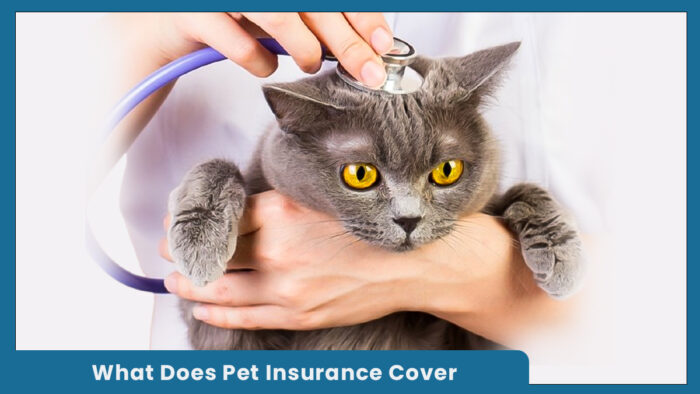What Does Pet Insurance Cover – Pet insurance helps pay for medical care when your pet needs it. If your dog or cat falls seriously ill or gets hurt, the cost of treatment can be high. That’s where pet insurance can make a big difference. It helps to reduce the financial stress of paying high medical bills for your pets.

However, coverage and benefits are not the same across all providers. So before signing up, it’s important to know exactly what each pet insurance plan includes. Meanwhile, we have different pet insurance coverage plans such as accident only coverage, accident and wellness coverage etc.
Types of Pet Insurance Coverage
When exploring pet insurance, you’ll usually come across three main types of plans. Each serves a different purpose, depending on your needs and your pet’s health.
1. Accident and Illness Coverage
This is the most popular type of pet insurance. It covers both unexpected accidents and health issues, giving you broader protection for your pet. If your dog breaks a leg or your cat develops a urinary tract infection, this type of plan helps cover the cost of care up to your policy’s limit. Here are some examples of what it may cover:
Accidents:
- Animal bites
- Bee stings
- Broken bones
- Car accidents
- Cuts and wounds
- Eye injuries
- Fractured teeth
- Poisoning
- Ruptured ligaments
- Swallowed objects
- Torn nails
Illnesses:
- Allergies
- Arthritis
- Cancer
- Diabetes
- Ear infections
- Heart disease
- Kidney issues
- Skin conditions
- Thyroid problems
- Urinary tract infections
- Vomiting and diarrhea
It offers the most complete protection. You’ll have a wide range of coverage options and the ability to tailor the policy to suit your pet and your budget.
2. Accident-Only Coverage
This plan only covers injuries from accidents. It doesn’t include treatment for illnesses like cancer or infections. Because it’s limited in scope, it usually costs less than a full accident and illness policy. It may be your only option if your pet is older and doesn’t qualify for a full coverage plan. It’s also helpful if you’re on a tighter budget but still want some level of emergency protection.
3. Wellness Plans
Wellness plans focus on preventive care. They’re often offered as an add-on to accident and illness coverage. These plans reimburse you for routine services that help keep your pet healthy year-round. Covered services might include:
- Annual checkups
- Vaccinations
- Blood tests
- Heartworm or FIV/FeLV testing
- Fecal tests
- Flea, tick, or heartworm medications
- Microchipping
- Deworming
- Dental cleaning
- Spay or neuter procedures
If you regularly schedule wellness visits and use most of the services listed, a wellness plan can help you save money. However, if you’re unlikely to use many of the benefits, it may cost more than what you’ll get back in reimbursement. Review the details and compare costs carefully before buying.
What Does Pet Insurance Cover?
Pet insurance helps with the cost of treating your pet when they get sick or injured. As long as the condition is included in your plan, your provider can reimburse you for things like surgery, prescription medication, diagnostic tests, hospital stays, and emergency care.
Beyond basic medical treatment, your plan may also include extra benefits depending on the coverage you choose.
Alternative and Rehabilitative Treatment:
Some policies include therapies like physical rehabilitation, acupuncture, or chiropractic care. Others offer this as an optional add-on. Since coverage for alternative treatments differs by provider, be sure to check the policy for details on what is included.
Behavioral Therapy:
If your vet recommends care for issues like aggression, separation anxiety, or compulsive behaviors, certain plans may help pay for the treatment. However, not all plans include this by default, and some charge more to add it.
Congenital and Hereditary Conditions:
Conditions like hip dysplasia or heart defects, which are inherited or present at birth, may be covered. Your pet must not have shown signs of the condition before you purchased the plan. Some providers may limit this type of coverage or exclude it entirely.
Exam Fees:
Many plans cover medications and treatments, but not the cost of the vet’s examination. Some include exam fees in the standard plan, while others treat it as an optional extra. Always read your plan to be sure.
Prescription Diets and Supplements:
If your vet prescribes a special diet or supplement to treat a health issue, some plans will reimburse you. However, many do not cover these items unless you pay for additional coverage.
Dental Care:
Dental coverage varies by provider. Some plans cover things like broken teeth or congenital dental issues but may not pay for common problems like gum disease. If dental disease is covered, your pet may need to have had a recent dental cleaning under anesthesia.
Routine dental cleanings are usually only covered if you have a wellness add-on.
Final Expenses:
When your pet passes, there may be unexpected costs such as euthanasia, cremation, or burial. Some policies cover part or all of these expenses. Others may not, so it’s good to check your plan ahead of time.
What Is Not Covered by Pet Insurance?
While pet insurance can be helpful, it does have limitations. Most plans do not cover:
Pre-existing Conditions:
If your pet had a health issue before the policy began or during the waiting period, that condition is unlikely to be covered. This includes both illnesses and injuries.
However, some companies make exceptions. For example, AKC may offer limited coverage for pre-existing conditions after one year in some states. Other providers might cover conditions that are considered curable if your pet has been symptom-free for a specific amount of time.
Bilateral Conditions:
If a health issue has affected one side of your pet’s body in the past, treatment for the same problem on the other side might not be covered. For instance, if your dog had a dislocated kneecap on the right leg before getting insured, and later develops the same issue on the left, your plan may not pay for either.
Let me know if you would like this split into a blog post layout or need follow-up content for wellness plans, costs, or choosing the right insurer.
Cosmetic or Elective Surgeries:
Pet insurance usually doesn’t cover procedures that aren’t medically necessary.
That means surgeries like ear cropping, tail docking, or declawing won’t be paid for unless a vet confirms they are needed for your pet’s health.
Routine and Wellness Care:
Basic preventive care often isn’t included in standard plans. Services like vaccinations, dental cleanings, and spaying or neutering are typically only covered if you purchase a separate wellness package.
Breeding Costs:
Expenses related to breeding or pregnancy are usually not covered. Some insurance companies may offer an additional option to include these, but it will cost more.
Pet Liability:
If your pet causes harm or damage, most pet insurance plans won’t help. However, your homeowners or renters insurance might cover situations like a dog bite or property damage.
How Pet Insurance Works
After you buy a pet insurance policy, you will usually need to wait before the coverage starts. Accidents may be covered within a few days, but illnesses often have a longer waiting period sometimes up to two weeks. Conditions like hip problems or ligament issues may require several months or even a year before they’re covered. If your pet gets sick during the waiting period, those conditions won’t be covered later and will be seen as pre-existing.
Most plans let you use any licensed vet, so you don’t have to worry about being “in network.” Usually, you pay the vet first, then send a claim to the insurance company for a refund. Some providers can pay the vet directly, helping you avoid large upfront costs. Each plan has a maximum amount it will pay every year. This could be $2,500, $10,000, or even unlimited, depending on your choice. If you spend more than your limit, you’ll pay the rest out of pocket. Some companies also have lifetime or per-condition limits, so it’s good to review these before buying.
Who Can Get Pet Insurance?
Most insurance plans are available for dogs and cats only. A few companies cover other animals. For example, ASPCA insures horses, and Nationwide offers policies for exotic pets like rabbits, birds, and snakes. Insurers may also have age restrictions. Most won’t insure pets younger than 6 to 10 weeks.
But older pets may be ineligible to start a new policy once they’re 8 to 14 years old. However, if your pet is already enrolled, you can usually keep the coverage for life as long as you pay your premiums. Some insurers may ask that your pet sees a vet before the policy begins. This is to confirm there are no health issues that would be excluded later.
Do You Really Need Pet Insurance?
Pet insurance isn’t required by law. Many people choose to pay vet bills themselves instead of getting a policy. This can be cheaper if your pet stays healthy.
But if your pet has a serious illness or injury, insurance could help cover large, unexpected costs. In extreme situations, it may even be the difference between getting treatment and having to make a tough decision due to finances.



